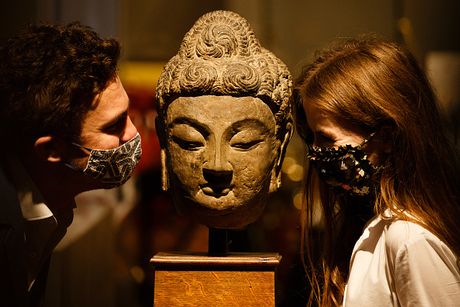
The gender pay gap in UK public museums has historically been narrow, a trend not mirrored by the country’s top auction houses. So far.
Today Bonhams released its 2022 pay gap report, revealing that women are now paid 92p for every pound men earn when comparing the median hourly wage. It is the closest parity of any major auction house since the UK government began requiring companies with more than 250 employees to submit pay data five years ago.
The new figures represent a 39% improvement on 2021, when Bonhams paid women 66p for every pound a man earned (in 2020 that figure was 48p for every pound). The percentage of women in the highest paid quartile increased from 28% in 2021 to 52% in 2022.
According to India Phillips, managing director of Bonhams in the UK, the company’s progress is the “cumulative result of a sustained company-wide effort to close the gender pay gap”. Over the past year, she adds, women made up 70% of promotions.
At Sotheby’s and Christie’s, meanwhile, there has been very little progress.
According to Sotheby’s 2022 report, women earn 73 cents for every pound men earn, so the pay gap now stands at 27%. This is a slight improvement on 2021, when women received 69p for every £1 from every man, but less than the 75p for every £1 earned by a woman in 2020. The percentage of women in the top quartile of Sotheby’s fell to 44%, down from 50% in 2021 and 48% in 2020.
A Sotheby’s spokesperson said that because 68% of positions below deputy director level in the company are held by women, and therefore pay less, “progress will be slow”. However, the spokesperson also notes that 76% of promotions to deputy director level in 2022 were female staff, and “as we reach the top quartile of our pay brackets, we are much more evenly split between men. and women”.
At Christie’s, the pay gap has gradually widened since 2020. In 2022, women earned 74p for every pound men earned, with a pay gap of 26.3%, up from 25.6% in 2021 and 24.4% in 2020. Women represented 48% of employees in the top quartile compared to 51% in 2021 and 50% in 2020.
A spokesperson for Christie’s notes that the pay gap is “skewed due to the greater representation of women than men in the organization”. They add: “Gender pay is different from equal pay. While our report reflects some progress, approximately 70% of the global workforce is female, which continues to impact our numbers. Approximately 70% of employees in our two lowest pay quartiles are women and approximately 50% of employees in the highest pay quartile are women. If we were to hire more men in more junior positions, that would impact the numbers.
The spokesperson acknowledges that systemic change must also occur to make a meaningful difference to the inequalities women face. As they put it: “There are wider societal issues at play, such as the fact that women are usually the primary caregivers and make the choice to change career paths. We need to make it easier for women to have both families and careers, and those efforts take longer to have an impact.
Only businesses and public sector bodies with more than 250 employees in the UK are legally required to report their pay figures, meaning virtually all commercial art galleries and dealers in the country are exempt. The Phillips auction house also falls into this category.
Meanwhile, the public sector – in which wages are generally lower – continues to offer a greater degree of equity, although this is not the case for all pay categories. At the Victoria & Albert Museum (V&A), women earn 3% more than men and hold 61.7% of the highest paid jobs and 54.1% of the lowest paid jobs; while at the National Portrait Gallery women’s salaries are 3.9% higher than men’s. However, this year’s numbers also show how a few key personnel changes can have a huge impact on bonus pay equity. At the British Museum, where women earn on average 9% more than men, the differences in bonus pay were significant, with female employees receiving 82% less in bonuses than men. This figure is much more uneven than last year, which saw women earn 15% less in bonuses than men.
The Tate Gallery, which includes four of the institution’s museums, reports that women earn £1.01 for every pound earned by men. What’s more, women’s pay is 33% higher, a figure not surprising considering that three out of four directors of the Tate’s museums, as well as its chief executive Maria Balshaw, are women. However, zooming out on Tate’s numbers reveals class issues. At Tate Enterprises, the company that employs most of Tate’s non-art staff, including housekeepers and café workers, women earn 9.8% less than men. And while at the Tate Gallery women hold 70.6% of the highest paying jobs, that number is 51.6% at Tate Enterprises.
Some of the UK’s biggest museums, such as the National Gallery in London and the National Galleries Scotland, have yet to release their 2022/23 reports.
